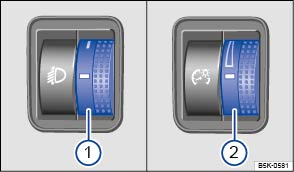Volkswagen Golf Owners Manual: Headlight range control, instrument and switch lighting

Fig. 83 Next to steering wheel: headlight range control
 First read and observe the introductory information
and safety warnings
First read and observe the introductory information
and safety warnings Headlight range control
Depending on what level it is set to, the headlight range control adjusts the position of the light cones in the headlights according to the load that the vehicle is carrying. This gives the driver the best visibility possible and means that oncoming traffic will not be dazzled .
The headlights can only be adjusted when the dipped beam headlights are switched on.
| To adjust, turn control to: | |
|---|---|
| Setting | Vehicle load levela) |
| – | Front seats occupied and luggage compartment empty. |
| 1 | All seats occupied and luggage compartment empty. |
| 2 | All seats occupied and luggage compartment fully loaded. Towing a trailer with a low drawbar load. |
| 3 | Only the driver seat occupied and luggage compartment fully loaded. Towing a trailer with maximum drawbar load. |
Dynamic headlight range control
There is no control ① for headlight range if the vehicle has dynamic headlight control. The headlight range is automatically adapted to suit the vehicle load level as soon as the headlights are switched on .
Instrument and switch lighting
The brightness of the instrument and switch lighting can be adjusted using the


 button and the
button and the  and
Light function buttons in the infotainment system .
and
Light function buttons in the infotainment system .
Depending on the vehicle equipment level, it may be possible to adjust the brightness of the instrument and switch lighting to suit your requirements by turning control when the headlights are switched on.
Instrument cluster lighting
The instrument cluster lighting switches off automatically in darkness and at other times, e.g. when driving through a tunnel. This is intended to prompt the driver to switch on the dipped beam so that the vehicle's rear lights are switched on .

 WARNING
WARNING
- The light cone should always be adjusted to the load level of the vehicle to ensure that other road users are not dazzled.

 WARNING
WARNING
- Proceed to a qualified workshop to have the headlight range control checked immediately.
a) If you have different loads, you can select a position between the settings.
 Coming Home and Leaving Home functions (orientation lighting)
Coming Home and Leaving Home functions (orientation lighting)
First read and observe the introductory information
and safety warnings The Coming Home function is switched on manually. However,
the Leaving Home function is controlled automatically by a twil ...
 Interior and reading lights
Interior and reading lights
First read and observe the introductory information
and safety warnings
Button
Function
Switches the front interior lights on or off.
...
Other materials:
Removing and installing exterior mirror adjuster -EX11-
Note
The removal and installation procedures are described for
LHD vehicles. Removal and installation for RHD vehicles are
similar.
Removing
Caution
Danger o ...
Contents
Fig. 217 Contents of the vehicle toolkit
First read and observe the introductory information
and safety warningsThe content of the vehicle toolkit depends on the vehicle
equipment level. The following describes the maximum scope.
The vehicle toolkit contains the following
Screwdriver w ...
Removing and installing centre underbody covers
Note
The removal and installation procedures may have to be modified
slightly depending on engine fitted.
Removing
Unclip spreader river -2- and remove
centre underbody panels.
Installing
Installation is carried out in reverse ...
